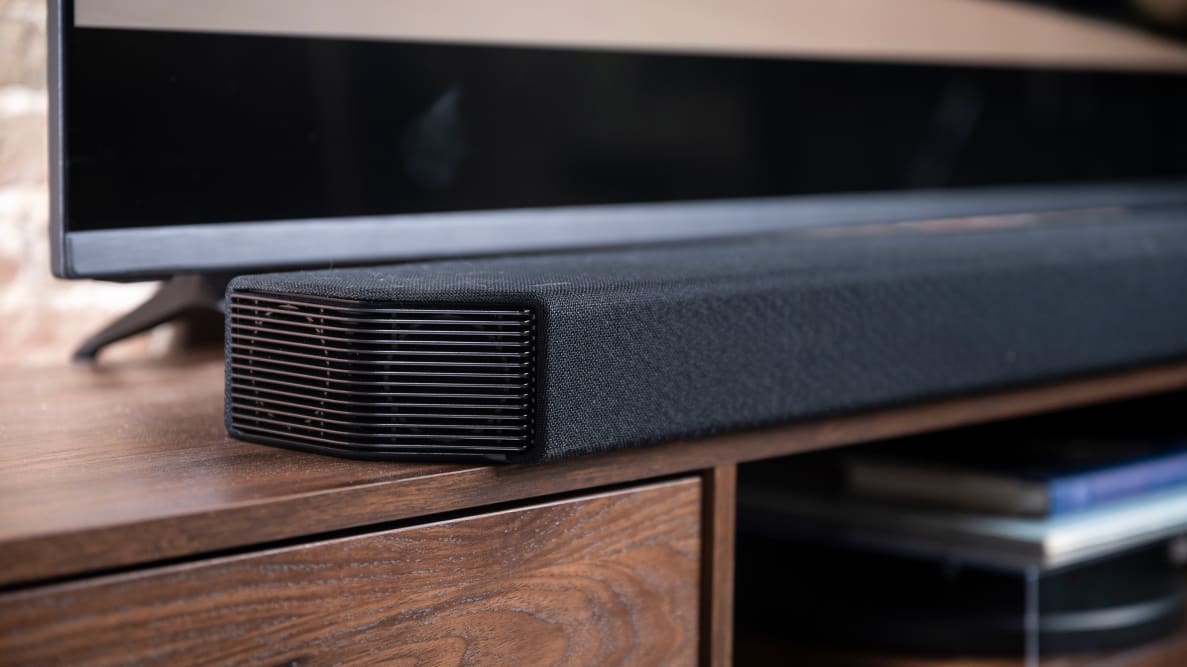Pros
-
Powerful, seamless immersion
-
Great musicality
-
Good app and feature set
Cons
-
Useless visual display
-
Hefty size and price
The step-up from last year’s HW-Q950T, Samsung’s latest mother-of-all-bars does what seemed like the impossible: cramming even more speaker drivers into its four-piece design. The 11.1.4-channel system one-ups its predecessor by sliding side-firing drivers not just in the bar itself but also in the wireless surround speakers, a trick I’ve yet to see in one of these systems.
Those go along with traditional front, right, and center channels, upfiring drivers at the front and back, a massive subwoofer, and more ways to bounce sound off your drywall than any system in its class. Is it overkill? Possibly. But it also leads to incredibly seamless immersion for surround and 3D content (either Dolby Atmos or DTS:X), and enough sonic force to rumble your seat. All that power is well-tuned, too. The result is a fantastic illusion that fully submerges you in the cinematic experience.
About the Samsung HW-Q950A
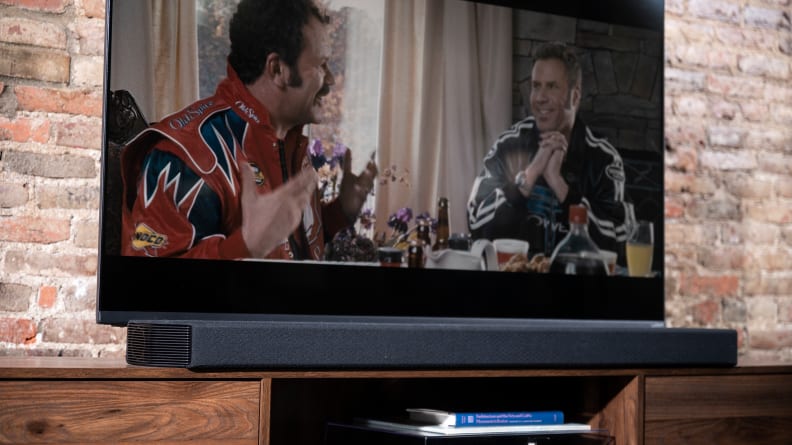
The system is powerful, but still easy to hide under your TV.
Here are the HW-Q950A’s main specs:
- Height x Width x Depth: 2.7 x 48.5 x 5.4 inches (soundbar), 15.9 x 8.3 x 15.9 (subwoofer), 8 x 4.9 x 5.6 (surrounds)
- Weight: 15.7 pounds (soundbar), 21.6 pounds (subwoofer), 4 pounds (surrounds)
- Speakers/drivers: 22 speakers total; 15 in the bar, three in each surround speaker, one 8-inch subwoofer
- Amplification: 246 watts in the bar, 210 watts in surround speakers, 160 watts in sub
- Wireless connection: Wi-Fi, Spotify Connect, AirPlay 2, Bluetooth 4.2
- Wired connection: HDMI ARC/eARC, HDMI in (2), digital optical
- Smart features: Built-in Alexa
- Sound formats: Samsung Q-Symphony, LPCM, Dolby Atmos, Dolby Digital Plus, Dolby TrueHD, DTS:X, DTS 5.1, DTS-HD, DTS-HD Master Audio, FLAC, WAV, MP3, AAC, OGG, AIFF
- Video support: 4K/HDR passthrough including Dolby Vision and HDR10
The Q950A takes some effort to set up, mainly because it is huge. After dragging it into your listening room, you’ll find the main accessories needed for operation, including the wand-style remote and batteries, an HDMI cable, wall mount kit, and power cables for the bar, subwoofer, and each of the surrounds. The latter connect wirelessly, but still need power (of course). There’s no optical cable but that input should only be used for legacy audio devices. HDMI eARC/ARC is the only way to source Dolby Atmos from your TV, and also allows you to use your TV remote for soundbar power and volume.
Once you’ve got all the speakers properly configured, simply connect everything to power, connect the HDMI cable to your TV’s HDMI eARC or ARC input, and you’re up. You’ll also want to download Samsung’s SmartThings app, not just for Wi-Fi connection, but also for easy access to basic settings like sound mode and input selection, EQ, and a few other settings. The app also offers initiation of auto EQ calibration via Samsung’s SpaceFit Sound+ system to tune the setup to your room.
What we like
An impressive feature set

The Q950A is pretty well loaded, including all the major features you'd expect.
The Q950A has just about every feature most setups demand. Connection options including dual HDMI inputs for 4K HDR passthrough from connected devices (we’d like to see three, but two’s not bad) and eARC connection which allows for fully uncompressed sound transference between an eARC connected TV. Wireless streaming options are pretty decked out, including both Spotify Connect and AirPlay 2 for Apple Music fans, though there’s no Chromecast connection so other streaming services may have to resort to Bluetooth (or an app on your TV).
Speaking of Google, unlike rival bars from Sonos and LG, the Q950A doesn’t support Google Assistant, though it does offer Amazon Alexa for basic smart control with an onboard microphone. This allows you to control basic functions with your voice and incorporate the bar into an Alexa smart home setup.
The system also has multiple sound modes, which are actually useful rather than just adding a bunch of trash reverb like some systems. The Standard mode gives you a straight-shot delivery of your audio, which works well for things like stereo-only listening, while Surround and Game modes help spread out the sound even for stereo tracks. Samsung’s Adaptive Sound—designed to automatically adjust sound in real time for the best experience—also works well. It’s hands off, and usually does a good job priming the sound.
As noted above, the system also supports plenty of audio formats, including the top two 3D-audio formats in DTS:X and, of course, Dolby Atmos. The system also supports high-resolution formats including Dolby TrueHD and, according to Samsung’s reps, DTS-HD and DTS-HD Master Audio (though they're not listed in the specs). The system can also decode high-resolution audio files at up to 24bit/192kHz, but playback is limited to 24bit/96kHz.
Other notable features include Samsung’s Q-Symphony system, which integrates the bar with TV speakers from select Samsung models, and the ability to connect wirelessly to select Samsung TVs as well.
Transformative immersion
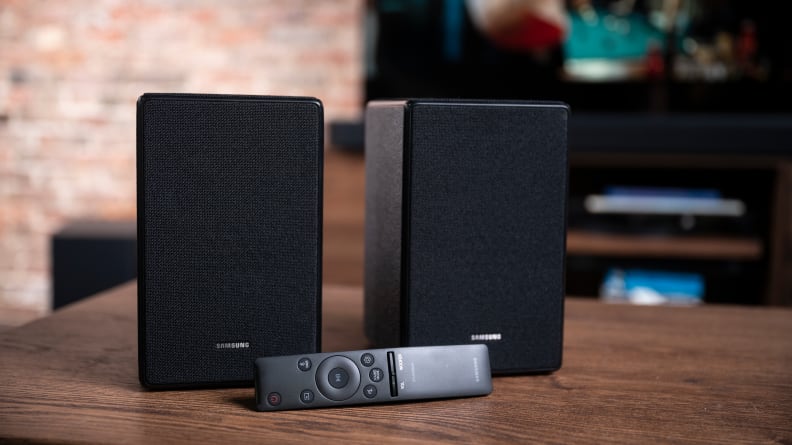
With tons of drivers, including multiple side-firing and upfiring solutions, the overall immersion is fantastic.
Most people haven’t experienced Dolby Atmos sound at its best. Even if you’ve been to a Dolby Atmos-equipped theater or experienced it in a soundbar or virtual setup, if it’s not tuned properly or the content doesn’t take advantage, you mostly lose out on the illusion. But once you’re in “the dome” you know it. And man is it fun.
It takes a bit of work to get the Samsung Q950A perfectly tuned—more work than it probably should, actually, which I’ll speak to below. But once you’ve got this system locked in, it is a thrilling experience. It’s not just the pumping bass that literally rumbled my couch cushions, the four-part height speakers, or even the smooth quality of the sound signature that makes the Q950A such an Atmos boss. Those are all integral, of course, but what takes this system to that next floor on the Atmos elevator is just how seamlessly it transfers sound across its speakers.
It’s likely the multitude of side-firing drivers plays a big hand in that, as does the size of the satellite speakers—they’re much larger than what you’ll get from cheaper Atmos setups, especially the tiny cubes you’ll find in entry-level surround bars. The hand-off between the bar and satellites makes the objects in Dolby Atmos demos like the fluttering seedling in Leaf, the animated crystal diamonds in Atmosphere, and the cruising spaceships that blow past your cheeks in Horizon really come alive.
Those demos are tailor-made for Atmos spectacle, of course, but the system is also fantastic for other well-made Atmos content like the Jedi episode in The Mandalorian season 2. The crunchy lightsaber blades burst in fiery swipes, while the blaster shots and other ambient sounds create a realist atmosphere. The bar outdoes Vizio’s excellent Elevate in such scenes (as it should at this price) and goes further to create the best Atmos experience I’ve encountered outside of a high-end discrete speaker setup.
Great for music and other content, too
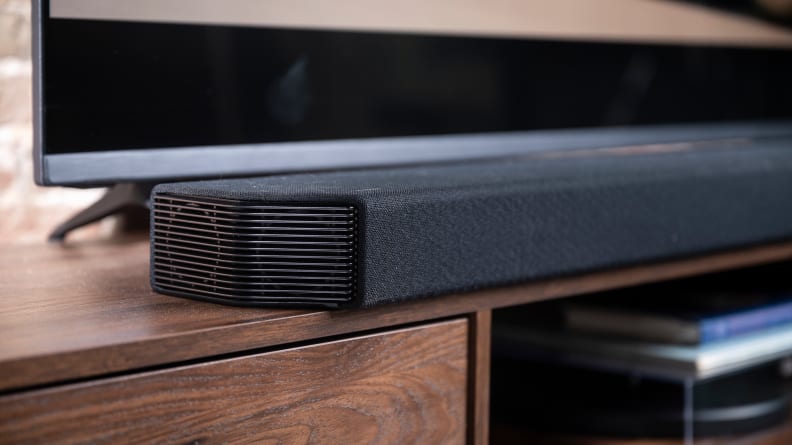
The system creates a clear and immersive experience for music as well as film and TV content.
One would think the makings of a great Dolby Atmos experience automatically transfer to any other content, but that’s not always the case. A system that goes all out for Atmos frequencies can sound tinny, overly synthetic, or bloated elsewhere, especially when it comes to music playback. I’m happy to report that, for the most part, that’s not the case here.
Musical playback is clear, full, and detailed enough that a friend who was over (because you can do that now) remarked on the bar’s performance multiple times. As we toured through a 3,500 song Spotify playlist, he repeatedly remarked how good it sounds and that it outperforms his own, aging multi-speaker system at home.
Personally, I’ll take my 2.1 KEF LSX setup, but for a system for which music is naturally secondary, the Q950A does quite well. Brass and woodwinds are sweet with plenty of headroom in the upper frequencies, acoustic instruments sound natural and smooth, and vocals are delivered with presence and definition.
I also have to admit I really enjoy listening in surround, even for stereo music. Adaptive Sound mode surprisingly spread stereo tunes across the full system. Albums like Manchester Orchestra’s Mask of God cloaked me in a dizzying cloud of synths, drums, and soaring vocals for a brilliant experience.
It’s also worth mentioning here just how ridiculously powerful the Q950A is. I don’t know how loud you’d have to play before distortion sets in, and I don’t want to. I do know that, in weeks of streaming music, I never once got above the very bottom cup of my phone’s volume bar. I don’t imagine anyone would ever turn the system above the midway point, but if they did, I wouldn’t want to be around for it.
To name some weaknesses, the bass occasionally gets boomy, and, especially with Hulu’s pedestrian stereo content, some dialogue can come off shouty in sitcoms like Seinfeld and Frasier, though not to the point of annoyance. I blame Hulu in part here, but my full-sized 2.1 setup has no such issues—and better detail, too. Overall, though, there’s little to complain about when it comes to sound.
The app is a big step up
It’s admittedly been a couple years since I’ve reviewed Samsung’s top Atmos bar, but in that time the company has learned from rivals like Sonos, which has an app so comprehensive that its Arc Dolby Atmos soundbar doesn’t come with a remote (and doesn’t need one).
Samsung’s SmartThings app isn’t quite there yet—Sonos is as much a software company as hardware—but it comes closer than expected, and for the most part beats out LG’s rival app experience. SmartThings is simple, cleanly laid out, and lets you access almost everything you need with an intuitive tap. That’s good because, while Samsung’s minimalist remote looks and feels good, unless you need a quick bump of the volume or woofer (the former you can handle with your TV remote over HDMI ARC connection), it’s pretty limited.
Not only that, while you’ll find a few front-facing LEDs, the Q950A’s visual display is, maddeningly, positioned on top of the soundbar where only god and your ceiling can see it. This brings me to my biggest complaint.
What we don’t like
The visual display is useless
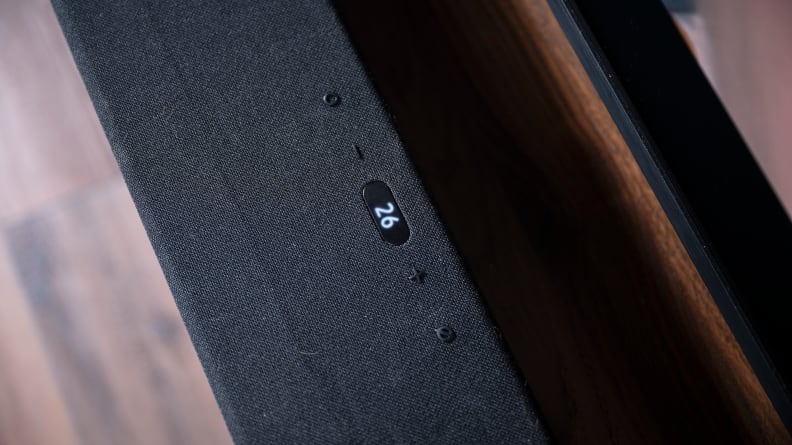
The display would be a welcome addition if it were usable. Luckily, a few app updates will make it obsolete anyway.
Somebody get the visual display person into somebody’s office because, seriously, how could anyone think the top of a soundbar is a good place to put it? Again, the vast majority of your settings are in the SmartThings app, so most people should get along just fine without ever even meeting the dark window that sits between the bar’s onboard controls.
Except, that is, if you need to adjust channel levels which, on a 22-speaker soundbar, you very well might. I’m personally a fiddler when it comes to surround systems—I like to get it just right. I will say that, while I’m not sure the calibration did much for the channel levels, the Q950A was in good shape on its own after auto calibration. But I did need to tweak the surround speaker volume down a few clicks, and raise the height speakers on the bar to get a thrilling overhead experience. And, surprisingly, this isn’t available in the app.
That leaves you standing above the bar, clicking the remote’s Settings button to the height channels, and then making guesses about how many points to adjust for the listening position (savage, I know). Jokes aside, it wasn’t a massive hassle and once things were locked in the SmartThings app took care of the rest. Still, cheaper bars from Vizio solve this issue with a display on the remote itself, while many LG soundbars put it prominently up front. On the plus side, the buttons on top of the bar are easy to use, including the mute button which will keep Alexa from listening when you want privacy.
A few more inputs would be nice
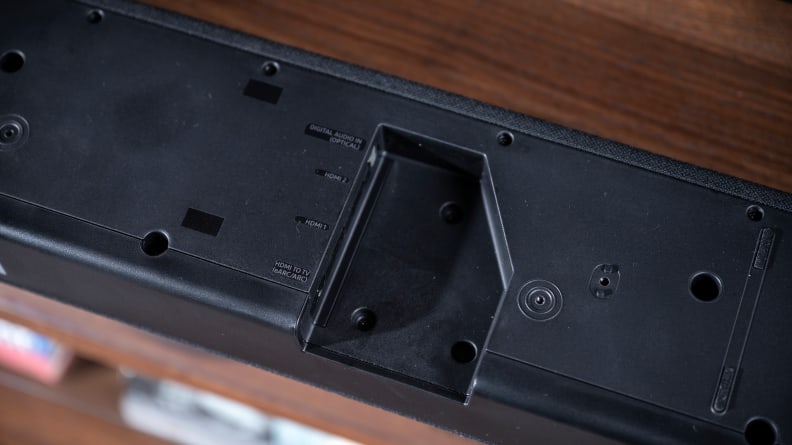
You'll get all the inputs you need, though we wouldn't have minded an extra HDMI and a USB port.
The HW-Q950a offers everything you need, including dual HDMI ports for connecting two components directly. That said, at this price another HDMI input would be nice since most people have multiple gaming devices and a streaming box, let alone a Blu-ray player. We'd also have loved to see a USB input here for high-resolution audio files, something you'll get from rivals in LG's SP soundbar line.
It’s a hefty from any angle
We always try to judge a system on its value, and it is hard to stomach a soundbar at this price point for anyone not in the six-figure salary range. Also, it’s just a damn big bar to drag around, so you’ll want to make sure you’re staying put if you set it up. It’s still way lower profile than a 7 or even 5-piece speaker system (and don’t forget the subwoofer), but this is a big honking system with a big honking price. You do pretty much get what you pay for, and as I write this Samsung has already dropped $200 off its $1,800 MSRP, which is fairly common.
Should you buy it?
Yes, it offers the best immersion shy of a multi-speaker setup

Samsung’s Q950A is big, brutish, and shockingly priced for a soundbar. You can literally get seven or eight 5.1 bars from your local Costco for its full price. But damned if it isn’t exquisite when you put the lights down and turn the sound up. It offers the best Atmos experience I’ve had in a soundbar, good musicality and, apart from a few quirks, easy operation to make it a good choice as the single, supremely powerful system in your marquee entertainment room.
You can certainly do pretty well for a lot less, though. Vizio’s value-packed Elevate is the first bar that comes to mind. At $1,000 or less, it offers a major chunk of the Q950A’s spoils when it comes to cinematic punch, though I like the Q950A a fair bit better for music. If you can still find it, you may also be able to get a great deal on the 2020 Q950T model. At this price, you can also look beyond soundbars and toward discrete home theater systems.
For a similar cost to the Q950A, you could deck out your room with SVS’ lovely 5.1 bookshelf system, a Denon 7.2 receiver and even add on Dolby Atmos speakers later for an extra $400. That totals more than the bar, but hey, in for a penny.
But even if you have the budget, not everyone has the know-how or space for several large-ish wooden cabinets. If that sounds like you, and you’ve got a hankering for major home theater might—Dolby Atmos included—the Q950A will not disappoint.
Meet the tester
Hailing originally from Montana, Ryan parlayed his time working as a musician and audio engineer into a career in digital media in 2012. Since then he's had extensive experience as a writer and editor, including everything from op-eds and features to reviews on TVs, audio gear, smart home devices, and more.
Checking our work.
Our team is here to help you buy the best stuff and love what you own. Our writers, editors, and experts obsess over the products we cover to make sure you're confident and satisfied. Have a different opinion about something we recommend? Email us and we'll compare notes.
Shoot us an email

